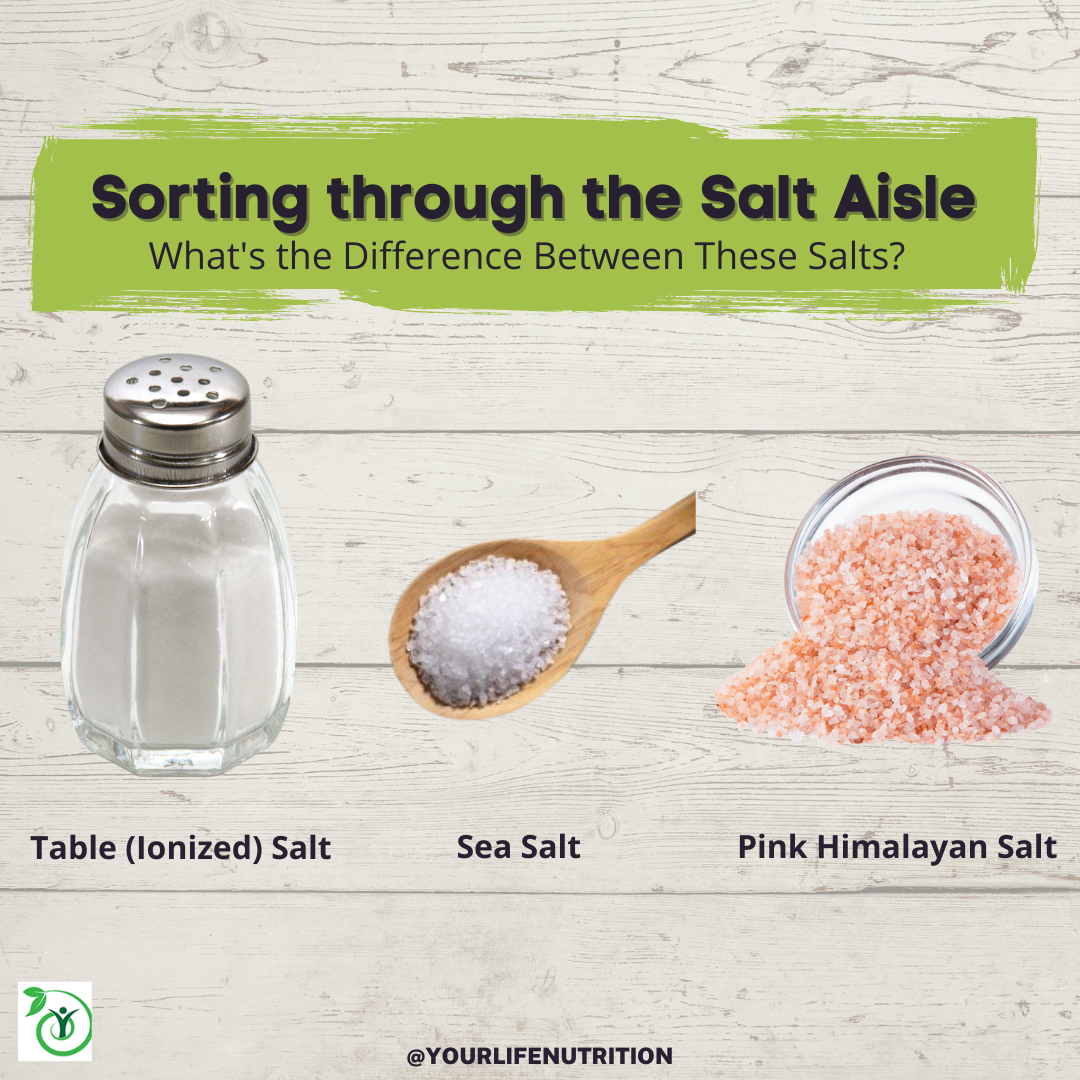When you go to the grocery store and walk down the aisles, it is easy to get overwhelmed by the thousands of different products and variations to choose from. One ingredient that is often found with several variations is salt. There are dozens of salt types and brands to pick from, but what is the difference between them? How do you know if one is better than the other, or if the price of one makes it healthier or more beneficial to your health? Well, we are going to discuss 3 of the most popular salt variations on the market including iodized table salt, sea salt, and pink Himalayan salt.

First up we have table salt, often referred to as ionized or refined salt.1 This is typically the salt you’ll find in your saltshakers and is the cheapest, easiest salt to keep on hand. The key here is that word refined.1 What does this mean? This type of salt originated in underground deposits and has to be processed to remove other minerals.1 When we buy this salt, it comes as a more powdered or granulated texture due to this process and is often fortified with iodine.1 Iodine is a mineral that plays an important role in thyroid health which is what controls hormones and metabolism.1 Thyroid deficiency was once a big problem and caused goiters in deficient individuals which is why refined table salt started being fortified with this mineral.1 However, iodine is not always the only thing added back into this salt.2 Oftentimes chemicals are added to prevent clumping to maintain a dissolvable product.2

Sea salt, to no surprise, begins its journey in the sea.2 The salt from the ocean is evaporated so only the salt crystals remain.2 It has larger crystals, more course, and has a bit more flavor.2 It often gets marked as “natural” which causes consumers to believe this is a healthier alternative to table salt, however the word “natural” has no regulation in the food industry and carries no guaranteed value when it comes to nutritional compostition.2 In fact, when it comes to sodium levels, table salt and sea salt are both around 40% sodium by weight.2 Sea salt is larger, so by volume there may be a slightly lower sodium level, simply meaning the larger crystals sea salt has spreads out the sodium more than the smaller, denser crystals of table salt. Imagine you have ten pieces of furniture to decorate a small room and the same ten pieces of furniture to decorate a room with twice as much space. It would feel a lot more cluttered in the small room than the big room, even though both have the same exact number of furniture pieces decorating them. This is kind of how it is for the different salts. The furniture has sodium inside, the small room is table salt, and the big room is sea salt.

So, we’ve talked about table (ionized) salt and sea salt, but what about pink Himalayan salt? Well, like sea salt, pink Himalayan salt is evaporated from sea water.3 So what makes it different? Location! Pink Himalayan salt comes from a mountain range in Pakistan which has been deposited from the ocean to the mountain whereas sea salt has no defined location and can result in variations of colors and mineral composition.3 Up to ten elements have been discovered in pink Himalayan salt including chromium, copper, zinc, iron, lead, magnesium, potassium, calcium, and sulfates.3 The pink hue comes from the oxides it contains and can sometimes appear as off-white and even appears red depending on the nutrient composition.3 Its dry crystals allow for rapid dissolving, more similar to table salt than sea salt.
So, what is the nutritional difference between these salts? Well, not much. If you think about it, all salt originated in the ocean, some found its way to the mountains, some stayed where it was at (in the sea).4 Why is this important? Well, all salt is still 98% sodium chloride, regardless of where we now extract it from.4 So when we are comparing differences in nutrient content, we are really only comparing their 2% difference which is not very significant.4 Nonetheless, there is a small difference between the three.

First, table (ionized) salt will probably have higher levels of iodine which is good, however it has been stripped of any other mineral that use to be present.4 The high heat and processing it has to go through strips any minerals from its nutritional value so only what is added back contributes to this 2%.4 Sea salt’s nutrient composition is very dependent on where the salt is taken from as different parts of the ocean contain different minerals.4 Finally, pink Himalayan salt is also packed with minerals like sea salt, specifically those listed above as well as silicon, phosphorus, vanadium, and iron.2
So, of the three which is healthiest? Well, this is kind of a trick question. If you are solely looking at sodium content, they are all essentially the same so the quantity is more important than the type.4 Watching the total amount of sodium should be the priority when it comes to salt consumption, so really any of these salts in high amounts is bad.4 If you looking at the entire composition of salt, sea salt and Himalayan do contain more beneficial minerals and are not put under chemically altering heat and temperatures.4 The benefit to ionized salt is the added iodine, so if you are planning to substitute it with sea salt of pink Himalayan, make sure you are getting your iodine elsewhere.4 Some examples of foods naturally rich in iodine include seaweed, fish, shellfish, dairy products, eggs, beef liver, and chicken.5

At the end of the day, when you find yourself staring at the different salts at the grocery store, choose the one you like the best and pay attention to the amount you are consuming. Try to get your total intake of sodium to 2,300 mg or less per day including added salts like the ones we’ve discussed as well as added salts found in processed and prepared foods.2 This is equivalent to one tsp of table salt, one tsp plus 1/5th tsp of sea salt, and 1 tsp plus 1/4th tsp of Himalayan salt.3,4
References
- Katherine Zeratsky RD. Is sea salt healthier than table salt? Mayo Clinic. https://www.mayoclinic.org/healthy-lifestyle/nutrition-and-healthy-eating/expert-answers/sea-salt/faq-20058512. Published September 14, 2021. Accessed February 22, 2022.
- Sea salt vs. table salt. www.heart.org. https://www.heart.org/en/healthy-living/healthy-eating/eat-smart/sodium/sea-salt-vs-table-salt. Accessed February 22, 2022.
- Osborn DR. Difference between sea salt and himalayan salt. Difference Between Similar Terms and Objects. http://www.differencebetween.net/object/comparisons-of-food-items/difference-between-sea-salt-and-himalayan-salt/. Published June 11, 2018. Accessed February 22, 2022.
- Table salt, kosher salt, sea salt, Himalayan salt. which one should I buy? Office for Science and Society. https://www.mcgill.ca/oss/article/health-nutrition-you-asked/table-salt-kosher-salt-sea-salt-himalayan-salt-which-one-should-i-buy. Published October 25, 2020. Accessed February 22, 2022.
- Iodine. The Nutrition Source. https://www.hsph.harvard.edu/nutritionsource/iodine/. Published October 19, 2021. Accessed February 22, 2022.
Post Created by the University of Akron student dietetic intern: Michaela Campbell





